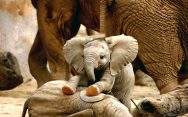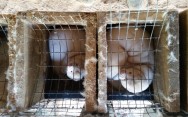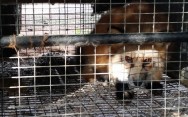Blog Archives
Home -
Posts tagged "Endangered Species"
The Sumatran tiger is the smallest sub-species of tiger – physically and in dwindling number. Fewer than 400 Sumatran tigers remain in their natural habitat of Sumatra. The tigers are under threat from poachers, palm oil farms and logging. A small number of tigers have recently been born through conservation programs in zoos, but the tiger is still declining every year in Sumatra.
Sumatra is the only place where some of the most endangered animals: rhinos, tigers, orangutans and elephants coexist. All are under threat from farming, logging and development. What’s more, if any of these species become extinct, it will affect the natural balance in the ecosystem.
One of the biggest threats to the tigers is Palm Oil plantations. Forest-clearing for logging and development and poaching are also a threat to the tigers. Three tigers were recently found dead, caught in traps that farmers leave for bears. Poachers have been encouraged by a loss of income during the Pandemic to illegally kill tigers for their teeth and other parts of the animal used in Chinese medicine.
How can this beautiful and rare animal be protected?
Making everyday choices as a consumer can help to protect wildlife and endangered animals and ecosystems. If you want to avoid being part of the demise of the Sumatran tiger you should avoid products containing palm oil, and/or look for products that are verified sustainable by the Forestry Stewardship Council.
To take a more active part in protecting the Sumatran tiger you can donate to organizations that are working to protect their numbers such as the Wildlife Conservation Society India, and the International Tiger Project.
The Sumatran Tiger is in danger. Please consider donating to help this beautiful animal make it into the next century and by sharing any links to donation pages on your social media page.
https://internationaltigerproject.org/
https://indonesia.wcs.org/Wildlife/Sumatran-Tiger.aspx
|
Tags: animal rights,
Apex Predator,
Big Game Hunting,
Ecosystem,
Endangered Animal,
Endangered Species,
Kevin Boileau,
Nazarita Goldhammer,
Palm Oil Plantations,
Poachers,
Sumatra,
Sumatran Tiger
Mountain lions in California are isolated, dejected, without chance of finding a mate and vulnerable to poisoning, death on highways and deliberate targeting by humans. That is the picture painted by this LA Times Article, ahead of a major decision by the Fish and Game Commission that went in favor of Mountain Lions. The Fish and Game Commission have decided to review the Mountain Lions’ Endangered status over 6 years and afford them certain protections in line with this. The article delves into the ways Mountain Lions should be protected. While these considerations apply to Mountain Lions, it would be even better if some of the protections could be universally applied to protect wild animals in shrinking habitats encircled by human development.
One suggestion the article makes is that highways should not restrict Mountain Lions’ Movements. It seems a no-brainer to require green overpasses for all animals in highway development plans. The needs of wild animals to roam freely and seek food and better conditions are fundamental. Animals may not be imprisoned in Wildlife Parks but encircled by “highways of death” they may as well be.
Then there are poisons. Poisoning animals that are considered pests doesn’t just kill them in an inhumane and horrible way, it also risks the life of any other animal happening upon this poison, whether by predation or by other exposure. Poisoning “pests” is the equivalent of planting landmines in wild animals’ natural habitats. Raptors like owls, for example, are much more likely to die from anticoagulant rodenticides. These poisons induce fatal bleeding in animals. It is an unthinkably cruel way to die.
The only reason people are starting to wake up to this inhumanity is that their own pets are sometimes killed by poisons. The sad and difficult lives of Mountain Lives tell a much bigger story about life for wild animals who are forced into exile on the borders of human habitats.
Read More:
https://www.sanluisobispo.com/news/local/environment/article243374736.html
https://www.sacbee.com/news/california/article237937419.html
https://messengermountainnews.com/mountain-lions-win-major-victory-at-fish-and-game-commission-meeting/
https://www.latimes.com/opinion/story/2020-04-15/mountain-lions-protection-freeways-rat-poison-property-owners
There are times when a death toll goes so high that the significance of numbers is nothing but the complete loss of their significance. No longer are numbers able to speak of the loss of the individual to a community, to a family, to a habitat. The only thing they are able to speak of is the loss of meaning, the incalculable damage done to life itself. When we hear of a human death toll – a disaster, a massacre — the number of dead hits us like a blow to our sense of individual destiny: the right we think we have to thrive, to matter. The dead are like a wave that sweeps across our consciousness, constantly overwhelming our efforts at recognition, at the distinction we humans find between ourselves and others, our environment. We are connected with others in our helpless masses, no longer as helpers or community members, but as mere victims. The numbers stand while we fall, unable to resist the magnitude, the amplitude of the loss.
The numbers of estimated animal dead in Australia cannot be compared to a human village, nor a town, nor even a nation. Instead, the numbers of estimated animal dead in Australia’s fires make up one eighth of the world’s human population today. This animal death toll doesn’t even include frogs and insects.
As humans, we work among the ruins of our own disasters to regain our personal significance. We cling on to activity: gestures of solidarity, statements about change that are as much made to feed the ego as to stake out a real commitment. We reassure ourselves that we are individuals, that we matter. In the wake of Australia’s fires, humans feeding baby koalas and wrapping them in blankets are broadcast as a signal of activity that fills the void of disaster. They speak of our ability to care, to matter, as helpers and agents for animals. Despite the great good of these activities, they do not speak of the loss and grief of animals themselves, nor of their situation as displaced individuals and families who have been devastated by Australia’s inadequate climate change policy.
The animals who have survived have lost their family members and in some cases their entire habitats or livelihoods. The best known example is the Koala, which has been decimated by the fires on Kangaroo island. These koalas had represented a sanctuary and a reserve, protected from the chlamydia that has kept other koalas from reproducing successfully. There are questions over whether a small marsupial which lives its life shielded from danger in greenery has any real shot of sustainable existence in its hollowed out home on Kangaroo island.
We humans imagine death from fire as striking these animals with explosive might, but before the fires, animals were already dying of exposure to intense heat. Birds were dropping out of trees. Animals were starving because their food supplies were drying to a crisp. The fires that have grabbed human attention have left animals homeless. Those who have survived and haven’t received medical attention are enduring great suffering from hunger and injury. The Australia fires have unearthed a world of animals who carry on their lives whether we notice or care or not.
We need to follow the story of animal lives beyond this crisis as they now evade opportunistic predators like feral cats, as livestock dead create bio-hazards for animals, as they move about and use their ingenuity to survive but often fail to make it. Animals, like humans, do what they can to survive, including sheltering together in wallaby burrows. Heroic working dogs have rescued animals from fires. The sight of injured animals, baby koalas clutching stuffed animals, should remind us that other species have their own emotional needs and communities. Everyday animal lives, not human heroism, are the ignored clues to helping animals and working alongside them. For example, it should have been clear by damage from the heat wave in Australia, and by animal behavior, that climate change disaster was already preying upon the animal population. The fear is that California “will be next.” The sovereignty of animal lives needs to be consistently observed and recognized outside of disaster scenarios. Waking up to animal sovereignty, animal pain, animal solidarity can transform the death of animals from a number into an accountability for the loss.
The rescue efforts are not going to stop when the fires start to disappear from the headlines. This article has some information on how to support the rescue efforts going on: https://www.cnet.com/how-to/australia-fires-have-killed-more-than-a-billion-animals-so-far-how-you-can-help/ However, ongoing donations to animal conservation organizations such as the World Wildlife Federation are needed indefinitely. Commitments to fight climate change and move away from animal exploitation and death are needed Right Now.
https://www.latimes.com/environment/story/2020-01-14/australia-fires-killed-millions-of-animals-kangaroo-island
https://www.cnet.com/how-to/australia-fires-have-killed-more-than-a-billion-animals-so-far-how-you-can-help/
https://www.nbcnews.com/science/environment/more-1-billion-animals-killed-australian-wildfires-n1112326
122 wolves in Washington State, struggling to recover their population since the 1990s – two dead in the last month, one the breeding female in the Profanity Peak pack. After a decision allowed state wildlife officials to shoot wolves in the Northeast Washington State area, two wolves have lost their lives. The female just shot this previous Friday was one of only a few members of the pack left, after Washington State officials decimated the pack in 2016.
It is a fragile existence for wolves, and their lives are constantly under threat. The last few years have been a massacre. According to the Center for Biological Diversity, many of the wolves killed in the last few years have been at the request of one cattle rancher.
These are not just individuals either – they are family members with important roles in the pack structure. It is incredibly tragic to think of the remaining, embattled wolves in these tiny packs, eking out their existence without the wolf family members they have lost.
Please read more about this situation and ask the state to find a better way to care for Washington’s wolves.
https://www.biologicaldiversity.org/news/press_releases/2018/wolf-08-20-2018.php
https://www.king5.com/article/tech/science/environment/lethal-action-against-new-washington-wolf-pack-approved-by-state/281-593202277
The comment period is coming to an end on a series of changes to the Endangered Species Act today. These changes have been portrayed as a way of giving industry “incentives” to protect wildlife. This is a roundabout way of saying that important regulations to protect wildlife will be removed to make way for industry. The argument for the changes revolve around the idea that since species are still endangered, the act isn’t working. This is like saying that we should remove social welfare because people are still poor.
The Endangered Species Act doesn’t protect all animals, but it has protected 99 percent of the animals it covers from extinction. It’s imperative for animals that we see through the deceitful arguments of the “regulation-shy.” These are nothing more than a veil for shifting the focus of conservation towards human interests and away from animal interests. The changes will:
– Remove protection from threatened species, if they are not officially endangered, allowing them to be hunted and trapped
– Exclude scientists from federal findings
– Change language to make it less clear-cut that species’ interests should trump economic ones
What is most outrageous is that these actions have been portrayed as reasonable. Handing power to business owners and vested economic interests is a recipe for disaster. What will it take for human beings to learn that a superior force will always harm the vulnerable if left unchecked? This is not an abstract philosophy, it’s the basic physics of how beings interact. It’s time to refuse this cowardice and shift the weight of our choices towards protecting the vulnerable. Please make your comment today and join the fight to protect endangered species.
Read more:
https://billingsgazette.com/opinion/columnists/guest-opinion-speak-up-by-sept-to-save-endangered-species/article_ad64ea21-2c1a-5c4e-9fe1-e0f6bdcdc072.html
https://www.missoulacurrent.com/outdoors/2018/09/endangered-species-act-3/
https://thehill.com/opinion/energy-environment/407847-proposed-changes-will-help-recover-endangered-species
Just as the world’s most recent ape species was discovered, their habitat is about to be decimated. The Northern Sumatran Tanpanuli Orangutan was only discovered last year, and the population is already known to be the most endangered ape species in the world. The orangutans are threatened by Chinese diggers constructing a hydroelectric dam that will divide their habitat in two.
The dam has been opposed by leading environmentalists. Research in top scientific journals has shown that its impact will be disastrous. Yet it still goes ahead because of an injection of funding from the Chinese State Bank. Other major funders have pulled money based on the impacts on the orangutans, amongst other things. The reason why this disastrous project is being protected is that it is part of a huge Chinese plan for infrastructure to facilitate trade. Projects like this will spring up elsewhere, harming other wildlife.
Videos show orangutans clawing at diggers who are moving into their habitat. Orangutan literally means “man of the forest.” We must stop the advance of human works of such magnitude and harm. The vulnerable are counting on us. Please sign and share.
See Also:
https://news.mongabay.com/2018/07/scientists-urge-indonesian-president-to-nix-dam-in-orangutan-habitat/
https://www.theguardian.com/environment/radical-conservation/2018/apr/23/worlds-newest-great-ape-threatened-by-chinese-dam
The group that came to the rescue of baby elephant Suman have released a video showing the elephant’s captor inflicting relentless violence on elephants. Wildlife SOS launched a campaign to save Suman the baby elephant, but still nothing has been done by the Rajasthan government, despite the fact that elephant trafficking is illegal.
The baby elephant was already in a delicate state when evidence of her captivity drew outrage. She was penned in a small cage, tied by her foot and making repetitive movements that clearly showed distress. Her parents and sister have since been reunited, but this six year old baby elephant is still at the mercy of almost certain violence, abuse and mistreatment. In the video her captor is shown mercilessly beating and tying up and burning the foot-pads of elephants. Humans who protested have also reportedly been fired or attacked.
Animal psychologists are worried about the damage this trauma will do to Suman. Elephants live just as long as humans and so the “memory of an elephant” could be a liability as well as a gift. The sooner the baby elephant can be freed, the more likely she is to heal from the harm and isolation done to her.
Please donate, share and sign Wildlife SOS’s petition: http://wildlifesos.org/save-suman/?gclid=EAIaIQobChMIsfTDgqTU2wIVTbnACh0VLgMOEAAYASAAEgIQ8PD_BwE
More Info on this story:
http://www.newindianexpress.com/nation/2018/jun/07/rajasthan-government-slammed-for-failing-to-take-action-against-owner-who-tortured-baby-elephant-1824676.html
http://www.dailymail.co.uk/news/article-5835245/Shocking-video-shows-Indian-trafficker-mercilessly-beat-burn-elephant.html
http://www.timesnownews.com/mirror-now/society/article/shocking-visual-of-merciless-trafficker-torturing-elephants-in-jaipur-goes-viral/239966
Because of a legal loophole, Japanese whalers can still kill large numbers of whales in the Antarctic every year, and this year, many pregnant and young whales were amongst the dead. Japan justifies these expeditions for scientific research, but their reasons are shaky.
For a start, the International Whaling Committee banned commercial whaling in 1985, and most countries, if not all, complied. A 1946 law that says whaling can still take place for scientific reasons is used as a justification for Japan’s expeditions. The whales on these expeditions can be sold for meat, leading to accusations that the scientific explanation is a convenient excuse. The scientific research is apparently undertaken to discover such factors as sexual maturity, nutritional condition and prey consumption of the whales. However critics have said this can be done by taking a biopsy instead. As well as claiming whale-hunting is done for scientific research, Japan has also defended its ancient “culture” of whaling.
122 pregnant whales and 114 juvenile whales died in this massacre. 333 whales in total were killed on this expedition. How did they die? By harpooning, ie using harpoons loaded with a 30g penthrite grenade.
Rather than terrorizing their population and using a violent method of killing them, Japanese whalers could find a more humane way of studying them, but they choose not to. Cultural inertia towards animals needs a wake-up call. Around the world, people are realizing that we don’t have to accept a cultural narrative about dominating and harming animals. It’s time to put pressure on the defenders of “cultural” cruelty to animals.
More info on this story:
https://www.nzherald.co.nz/world/news/article.cfm?c_id=2&objectid=12061465
https://www.bbc.com/news/world-asia-44307396
https://www.news.com.au/national/queensland/japan-whaling-kills-122-pregnant-whales-for-research/news-story/a1851aeec523563c79d593df7085e61b








Social Media